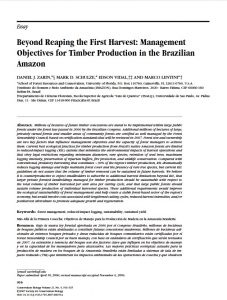No podemos encontrar internet
Intentando reconectar
¡Algo salió mal!
Espera mientras volvemos a la normalidad

Beyond reaping the first harvest: management objectives for timber production in the Brazilian Amazon
05/06/07| Título | Beyond reaping the first harvest: management objectives for timber production in the Brazilian Amazon |
|---|---|
| Autores | Daniel J. Zarin Mark D. Schulze Edson Vidal Marco Lentini |
| Periódico | Conservation Biology |
| Cidade | Curitiba |
| Ano de publicação | 2007 |
| DOI | https://doi.org/10.1111/j.1523-1739.2007.00670.x |
Zarin, D., Schulze, M., Vidal, E., & Lentini, M. 2007. Beyond reaping the first harvest: management objectives for timber production in the Brazilian Amazon. Conservation Biology, 21(4), 916-925.
 Abstract
Abstract
Millions of hectares of future timber concessions are slated to be implemented within large public forests under the forest law passed in 2006 by the Brazilian Congress. Additional millions of hectares of large, privately owned forests and smaller areas of community forests are certified as well managed by the Forest Stewardship Council, based on certification standards that will be reviewed in 2007. Forest size and ownership are two key factors that influence management objectives and the capacity of forest managers to achieve them. Current best ecological practices for timber production from Brazil’s native Amazon forests are limited to reduced-impact logging (RIL) systems that minimize the environmental impacts of harvest operations and that obey legal restrictions regarding minimum diameters, rare species, retention of seed trees, maximum logging intensity, preservation of riparian buffers, fire protection, and wildlife conservation. Compared with conventional, predatory harvesting that constitutes >90% of the region’s timber production, RIL dramatically reduces logging damage and helps maintain forest cover and the presence of rare tree species, but current RIL guidelines do not assure that the volume of timber removed can be sustained in future harvests. We believe it is counterproductive to expect smallholders to subscribe to additional harvest limitations beyond RIL, that larger private forested landholdings managed for timber production should be sustainable with respect to the total volume of timber harvested per unit area per cutting cycle, and that large public forests should sustain volume production of individual harvested species. These additional requirements would improve the ecological sustainability of forest management and help create a stable forest-based sector of the region’s economy, but would involve costs associated with lengthened cutting cycles, reduced harvest intensities, and/or postharvest silviculture to promote adequate growth and regeneration.
 PT
PT
 ES
ES
 EN
EN

